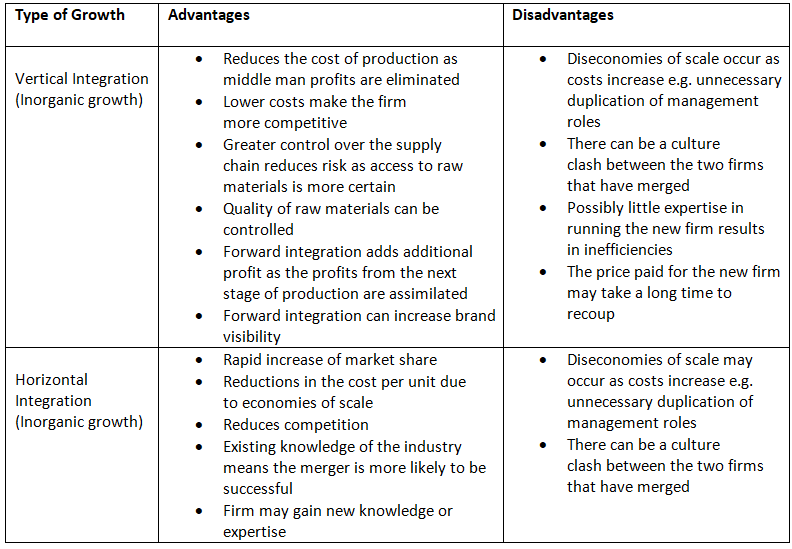Year 11 Exam > Year 11 Notes > Business Studies for GCSE/IGCSE > Types of Business Growth
Types of Business Growth | Business Studies for GCSE/IGCSE - Year 11 PDF Download
Reasons for Business Growth
- Many businesses commence on a small scale and progress to become large enterprises or even global entities. For instance, the colossal success story of Amazon, which originated in a modest garage.
Reasons why Businesses grow

Methods of Business Growth
- Business growth can be achieved through organic or inorganic means.
Organic (Internal) Growth
- Organic growth involves expanding internally using reinvested profits or loans.
- This type of growth is typically driven by:
- Gaining a larger share of the market
- Diversifying products
- Opening new stores
- Expanding into international markets
- Investing in new technology or production machinery
Examples of Organic Growth

- Expanding product diversity introduces fresh revenue avenues for a business.
- Companies might allocate funds towards research and development or enhancing existing products to facilitate the emergence of novel revenue channels.
- Businesses commonly experience organic growth until they attain financial stability to engage in integration through mergers or acquisitions with other entities.
- Integration accelerates growth but also presents new hurdles to overcome.
An Explanation of the Advantages & Disadvantages of Internal Growth

Inorganic (External) Growth
- Firms typically expand internally until they are financially capable of merging or acquiring other entities. This type of growth, achieved through mergers or takeovers, leads to swift business expansion known as external or inorganic growth.
- Merger: This involves the combination of two or more companies to establish a new entity where the original companies dissolve, and their assets and liabilities are transferred to the newly formed organization.
- Takeover: Involves one company purchasing another, often forcibly, by acquiring a controlling stake (>50%) and assuming control over its operations.
- Inorganic growth, on the other hand, typically occurs through mergers, specifically vertical integration (forward or backward) and horizontal integration.
Question for Types of Business GrowthTry yourself: What is organic growth in business?View Solution
Diagram showing forward and backward vertical integration

- Forward Vertical Integration: This occurs when a company merges with or takes over a business located further up the supply chain. For instance, a dairy farmer merging with an ice cream manufacturer.
- Backward Vertical Integration: Involves merging or taking over a business located further down the supply chain. For example, an ice cream retailer acquiring an ice cream manufacturer.
An Explanation of the Advantages & Disadvantages of each type of Growth

The document Types of Business Growth | Business Studies for GCSE/IGCSE - Year 11 is a part of the Year 11 Course Business Studies for GCSE/IGCSE.
All you need of Year 11 at this link: Year 11
|
70 videos|94 docs|25 tests
|
FAQs on Types of Business Growth - Business Studies for GCSE/IGCSE - Year 11
| 1. What are some common reasons for business growth? |  |
Ans. Some common reasons for business growth include increasing market demand, expanding into new markets, gaining a competitive edge, and maximizing profits.
| 2. What are some methods of business growth? |  |
Ans. Some methods of business growth include mergers and acquisitions, diversification, franchising, strategic partnerships, and product development.
| 3. What are the types of business growth? |  |
Ans. The types of business growth include organic growth (expanding internally), inorganic growth (through mergers and acquisitions), horizontal growth (expanding into related industries), vertical growth (expanding within the same industry), and lateral growth (diversifying into unrelated industries).
| 4. How can businesses ensure successful growth? |  |
Ans. Businesses can ensure successful growth by conducting thorough market research, developing a clear growth strategy, investing in technology and infrastructure, hiring and retaining top talent, and maintaining a strong company culture.
| 5. What role does innovation play in business growth? |  |
Ans. Innovation plays a crucial role in business growth by helping companies stay ahead of the competition, drive product development, meet customer needs, and adapt to changing market trends.
Related Searches


















